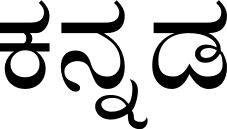Language/Kannada/Vocabulary/Feelings-and-Emotions
Hi Kannada learners! 😊
In this lesson, we will focus on feelings and emotions in Kannada. Learning how to express yourself is essential when learning a new language. By the end of this lesson, you will know how to talk about your emotions and feelings in Kannada. Don't forget to practice and use what you learn with native speakers on Polyglot Club. You can find native speakers and ask them any questions!
Consider broadening your understanding by checking out these related lessons: Travel Phrases & Clothes.
Vocabulary[edit | edit source]
- Basic emotions
Let's start with the basic emotions that we all feel:
| Kannada | Pronunciation | English |
|---|---|---|
| ಸಂತೋಷ (saṃtōṣa) | /sənˈtoʃə/ | happiness |
| ದುಃಖ (duḥkha) | /dʊkʰə/ | sadness |
| ಹೆದರಿಕೆ (hedarikē) | /hɛdaɾikɛ/ | fear |
| ಘೋರ (ghōra) | /ɡʱoːɾə/ | anger |
| ದ್ವೇಷ (dvēṣa) | /dʋeːɕə/ | hatred |
| ಆಶಾ (āśā) | /aːʃaː/ | hope |
| ವಿಶ್ವಾಸ (viśvāsa) | /ʋɪɕʋaːsə/ | trust |
| ಗೌರವ (gaurava) | /ɡɔu̯ɾəʋə/ | respect |
| ಘಾಸು (ghāsu) | /ɡʱaːsu/ | disgust |
- Compound emotions
Now, let's learn some compound emotions that we often experience:
| Kannada | Pronunciation | English |
|---|---|---|
| ಶಾಂತಿ ಹಾಗೂ ಸಮಾಧಾನ (shānti hāgu samādhāna) | /ʃaːnti haːɡu samaːdʱaːna/ | peace and tranquility |
| ಆತ್ಮೀಯತೆ ಹಾಗೂ ಸ್ನೇಹ (ātmīyate hāgu sneha) | /aːtmiːjate haːɡu sneha/ | intimacy and affection |
| ಆತ್ಮವಿಶ್ವಾಸ ಹಾಗೂ ಸಂಬಂಧ (ātmaviśvāsa hāgu saṃbaṃdha) | /aːtmaʋiɕʋaːsa haːɡu sandʱə/ | self-confidence and connection |
- Phrases
Here are some key phrases that you can use to talk about your feelings and emotions:
| Kannada | Pronunciation | English |
|---|---|---|
| ಈಜಿಕೊಂಡಿದ್ದೇನೆ (ījikoṇḍiddēne) | /iːd͡ʒikoŋdɪddeːne/ | I am happy |
| ದುಃಖಿಸುತ್ತೇನೆ (duḥkhisuttēne) | /dʊkʰisuɖɖeːne/ | I am sad |
| ಹೆದರುತ್ತೇನೆ (hedaruttēne) | /hɛd̪ərutːeːne/ | I am afraid |
| ಕೋಪಗೊಂಡಿದ್ದೇನೆ (kōpagonḍiddēne) | /koːpagoŋdɪddeːne/ | I am angry |
| ಸಂತೋಷ ಆದಂತಿನಲ್ಲಿ (saṃtōṣa ādaṃtinalli) | /sənˈtoʃə aːdəmtinəllɪ/ | in a happy mood |
| ನನಗೆ ಕಳಿಸಿಕೊಳ್ಳಬೇಡಿ (nanage kaḷisikolla bēḍi) | /naːnaɡe kaɭisikoɭɭabɛːɖɪ/ | don't make me angry |
Let's see these phrases in action:
- Person 1: ಈಜಿಕೊಂಡಿದ್ದೇನೆ (ījikoṇḍiddēne) (I am happy)
- Person 2: ಸಂತೋಷ ಆದಂತಿನಲ್ಲಿ (saṃtōṣa ādaṃtinalli) (in a happy mood)
- Person 1: ದುಃಖಿಸುತ್ತೇನೆ (duḥkhisuttēne) (I am sad)
- Person 2: ಏನು ಘಟಿಸಿದೆ? (enu ghaṭiside?) (What happened?)
- Person 1: ಹೆದರುತ್ತೇನೆ (hedaruttēne) (I am afraid)
- Person 2: ನನ್ನೊಂದಿಗೆ ನೀವೂ ಬನ್ನಿ (nannondige nīvū banṇi) (come with me)
- Person 1: ಕೋಪಗೊಂಡಿದ್ದೇನೆ (kōpagonḍiddēne) (I am angry)
- Person 2: ಕ್ಷಮಿಸಿ ನನ್ನನ್ನು (kṣamisi nannannu) (forgive me)
Culture and Interesting Facts[edit | edit source]
Kannada is a language spoken in the Indian state of Karnataka. Kannada is the official and administrative language of Karnataka. It is also one of the classical languages of India with a rich history and literature. Kannada literature dates back to the 9th century and has a unique place in Indian literature.
In Kannada, different dialects exist depending on the region. However, the standard dialect is based on the dialect spoken in the southern region of Karnataka. This dialect is also known as the Mysore dialect. Indian films are a significant part of Kannada culture, and the Kannada film industry produces many movies each year.
Sources[edit | edit source]
➡ If you have any questions, please ask them in the comments section below.
➡ Feel free to edit this wiki page if you think it can be improved. 😎
Videos[edit | edit source]
Sad Feeling Songs | Kannada Love Sad Songs - YouTube[edit | edit source]
Other Lessons[edit | edit source]
- Food
- How to say Good Bye?
- How to Say Hello and Greetings
- Days of the week (dinagalu)
- Education
- Resources
- Days of the Week
- Colors
- Express Surprise

